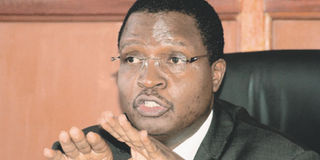County assemblies begin taking shape

FILE | NATION
Task Force on Devolved Government chairman Mutakha Kangu during a past meeting.
The make-up of county parliaments has started taking shape after a taskforce on devolution proposed their membership.
And Nairobi has emerged as the largest, with 135 County Assembly representatives.
The membership of the assemblies, with Lamu and Isiolo posting the lowest numbers of 25 representatives each, comes a few days after the Task Force on Devolved Government released six draft Bills that will bring into force the new units.
In what is likely to stir a fresh round of heated debate, the taskforce chaired by Moi University law lecturer Mutakha Kangu, uses the controversial list of 80 new constituencies mapped out by the Ligale commission to calculate the size of each County Assembly.
The sizes of the 47 County Assemblies as well as the six draft Bills will be under scrutiny during a stakeholders retreat to be held in Naivasha this weekend. The retreat will be chaired by Local Government minister Musalia Mudavadi, whose ministry is coordinating the laws on devolution.
Fourth largest
The taskforce allocates 97 seats to the Kakamega and Kiambu county assemblies. The two counties have 12 constituencies each while Nairobi has 17, going by the Ligale list.
Nakuru, which is the fourth largest county in the country with 11 constituencies, has been allocated 90 seats.
Kisii, Bungoma and Meru counties, which have nine constituencies each, have been allocated 75 seats each.
They are followed by the eight-constituency counties of Machakos, Migori, Homa Bay and Kitui, whose assemblies have been allocated 67 seats each.
Following Lamu and Isiolo counties on the tail end of the list are Tharaka Nithi, Tana River, Samburu and Laikipia, which have been allocated 26 slots in their respective assemblies. According to the Ligale Commission list, each of these counties ought to have three constituencies.
The taskforce has proposed that eight counties which have four constituencies each be allocated 34 seats in their respective County Assemblies.
The eight are West Pokot, Embu, Elgeyo Marakwet, Kirinyaga, Kwale, Nyamira, Taita Taveta and Marsabit.
Trans Nzoia, Bomet, Nyandarua, Vihiga and Kajiado with five constituencies each have been allocated 43 seats. A total of 13 counties with six constituencies each will get 51 seats in their respective assemblies.
They are Narok, Turkana, Nandi, Makueni, Wajir, Baringo, Siaya, Mandera, Garissa, Nyeri, Kericho, Uasin Gishu and Mombasa.
Murang’a, Busia, Kilifi and Kisumu counties with seven constituencies each will have 60-member county assemblies.
According to the Constitution, each County Assembly shall comprise one member elected at the ward level during a General Election. The County Assembly shall also have members nominated by political parties to represent marginalised groups and to ensure that no single gender has more than two thirds majority in the assembly.
Members shall serve a term of five years.
The Task Force determined that for a County Assembly to effectively fulfill its oversight functions, it required to have a minimum of 25 members. To ensure that the Assemblies adequately address the law of gender balance and marginalized groups, the task force set a maximum of seven and minimum of four special seats for each county.
Where the total number of members to a county assembly, including those representing special interests did not reach 25, the task force would raise it to 25 for effective representation.
For the purposes of determining the number of wards per county, the Kangu team resolved that each of the 290 constituencies contemplated in the constitution should have a minimum of three and a maximum of five wards.
A section of MPs mainly from Central, Coast and Northern Kenya are opposed to the Ligale list on grounds that it does not reflect the population and physical sizes of their regions.
The list has however found favor with MPs from Rift Valley, Nyanza, Western and parts of Northern Kenya who say it has addressed the hitherto skewed constituency distribution in the country.
According to the constitution, the County Assembly shall act as the legislative arm of the County Government headed by a Governor.
Reads Article 185(2) of the constitution: “A county assembly may make any laws that are necessary for, or incidental to, the effective performance of the functions and exercise of the powers of the county government under the Fourth Schedule.”
“A county assembly, while respecting the principle of the separation of powers, may exercise oversight over the county executive committee and any other county executive organs,” it goes on.
A County Assembly can also approve plans and policies for the management and exploitation of the county’s resources and the development and management of its infrastructure and institutions.




